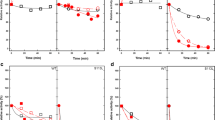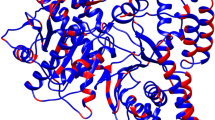Summary.
Mitochondrial carnitine palmitoyltransferases I and II (CPTI and CPTII), together with the carnitine carrier, transport long-chain fatty acyl-CoAs from the cytosol to the mitochondrial matrix for β-oxidation. As an enzyme that catalyzes the rate-limiting step in fatty acid oxidation, CPTI is inhibited by malonyl-CoA, the first intermediate in fatty acid synthesis. Our development of a high level of expression for CPTI and CPTII in P. pastoris, a yeast with no endogenous CPT activity has enabled us to map the malonyl-CoA and substrate binding sites by mutational analysis. Using deletion and substitution mutants of L-CPTI expressed in P. pastoris, we have shown that Glu3 and His5 are necessary for malonyl-CoA inhibition and high-affinity binding of L-CPTI but not for catalysis. Similar studies of M-CPTI clearly establish that the N-terminal residues Glu3, Val19, Leu23, and Ser24 in M-CPTI are important for malonyl-CoA inhibition and binding, but not for catalysis. Furthermore, using chimeras between rat and pig L-CPTI, and deletion mutation analysis, we demonstrated that the differences in malonyl-CoA sensitivity observed between the pig and rat L-CPTI were due to differences in the interaction of the first 18 N-terminal amino acid residues with the C-terminal region of the respective enzymes. Consistent with this, the conserved C-terminal residues R601, E603, R606, and K560 were found to be important for L-CPTI activity, malonyl-CoA inhibition and binding, because mutation of these residues decreased malonyl-CoA sensitivity and enzyme activity. We also identified two conserved C-terminal residues in L-CPTI, D567, and E590, that when mutated to alanine cause a substantial increase in malonyl-CoA sensitivity, suggesting a structural basis for the differences in malonyl-CoA sensitivity between L-CPTI and M-CPTI. Our cysteine-scanning mutagenesis of M-CPTI revealed that a single Cys residue, Cys305, was essential for catalysis. In addition, deletion and substitution analysis of the extreme C-terminal region of M-CPTI, suggest that L764 may be important for proper folding and optimal activity. In summary, our structure-function studies with the mitochondrial carnitine palmitoyltransferases I and II have identified critical residues for inhibitor and substrate binding and catalysis.
Similar content being viewed by others
Author information
Authors and Affiliations
Corresponding author
Rights and permissions
About this article
Cite this article
Woldegiorgis, G., Dai, J. & Arvidson, D. Structure-Function Studies with the Mitochondrial Carnitine Palmitoyltransferases I and II. Monatsh. Chem. 136, 1325–1340 (2005). https://doi.org/10.1007/s00706-005-0334-7
Received:
Accepted:
Published:
Issue Date:
DOI: https://doi.org/10.1007/s00706-005-0334-7




